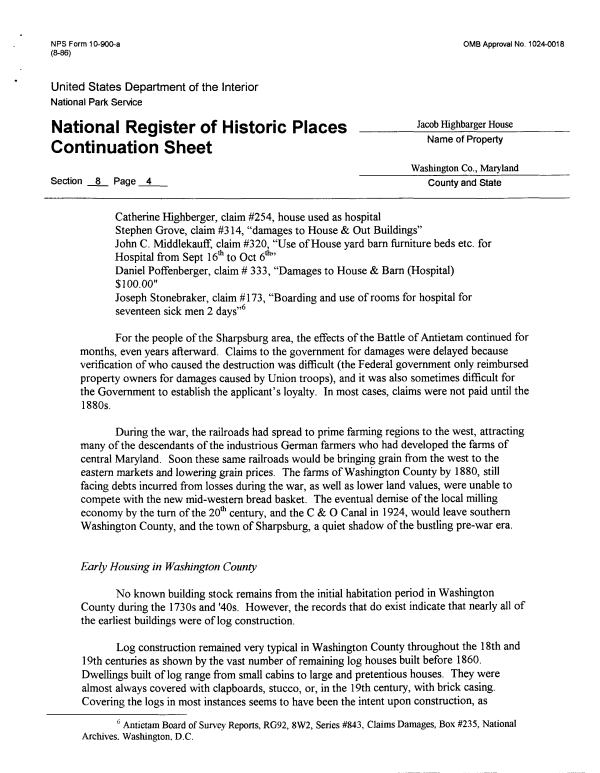 |
||||
|
DEPARTMENT OF HOUSING AND COMMUNITY DEVELOPMENT, MARYLAND HISTORICAL TRUST (Historic Sites Survey) var.d. MSA SE16-10 Image No: se16-10-0417 Enlarge and print image (63K) |
 |
||||
|
DEPARTMENT OF HOUSING AND COMMUNITY DEVELOPMENT, MARYLAND HISTORICAL TRUST (Historic Sites Survey) var.d. MSA SE16-10 Image No: se16-10-0417 Enlarge and print image (63K) |
| NFS Form 10-900-a OMB Approval No. 1024-0018 (8-86) United States Department of the Interior National Park Service National Register of Historic Places ___Jacob*&**<&House___ s* *• .. f\, i Name of Property Continuation Sheet Washington Co., Maryland Section 8 Page _4__ County and State Catherine Highberger, claim #254, house used as hospital Stephen Grove, claim #314, "damages to House & Out Buildings" John C. Middlekauff, claim #320, "Use of House yard barn furniture beds etc. for Hospital from Sept 16th to Oct 6th" Daniel Poffenberger, claim #333, "Damages to House & Barn (Hospital) $100.00" Joseph Stonebraker, claim #173, "Boarding and use of rooms for hospital for seventeen sick men 2 days"6 For the people of the Sharpsburg area, the effects of the Battle of Antietam continued for months, even years afterward. Claims to the government for damages were delayed because verification of who caused the destruction was difficult (the Federal government only reimbursed property owners for damages caused by Union troops), and it was also sometimes difficult for the Government to establish the applicant's loyalty. In most cases, claims were not paid until the 1880s. During the war, the railroads had spread to prime farming regions to the west, attracting many of the descendants of the industrious German farmers who had developed the farms of central Maryland. Soon these same railroads would be bringing grain from the west to the eastern markets and lowering grain prices. The farms of Washington County by 1880, still facing debts incurred from losses during the war, as well as lower land values, were unable to compete with the new mid-western bread basket. The eventual demise of the local milling economy by the turn of the 20th century, and the C & O Canal in 1924, would leave southern Washington County, and the town of Sharpsburg, a quiet shadow of the bustling pre-war era. Early Housing in Washington County No known building stock remains from the initial habitation period in Washington County during the 1730s and '40s. However, the records that do exist indicate that nearly all of the earliest buildings were of log construction. Log construction remained very typical in Washington County throughout the 18th and 19th centuries as shown by the vast number of remaining log houses built before 1860. Dwellings built of log range from small cabins to large and pretentious houses. They were almost always covered with clapboards, stucco, or, in the 19th century, with brick casing. Covering the logs in most instances seems to have been the intent upon construction, as 6 Antietam Board of Survey Reports, RG92, 8W2, Series #843, Claims Damages, Box #235, National Archives. Washington. D.C. |